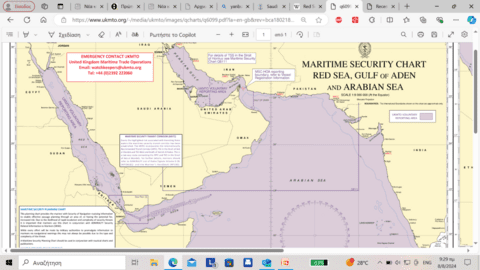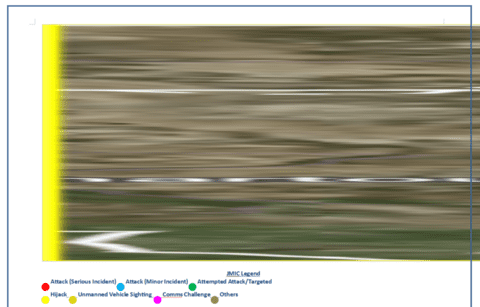
THREAT & RISK ASSESSMENT BRIEF UPDATE
Brief Update No 24/006 Date: 30 – Oct – 2024
STATEMENT
This document has been approved for distribution by Sea Guardian S.G. Ltd / Operations Department. The provided Intel and information derive from open sources, the Joint Maritime Information Center (JMIC) and United Kingdom Maritime Trade Operations (UKMTO) respective WebPages and products. All rights reserved. No part of this Risk Assessment may be reproduced in any form: electronic, mechanical, or other means without written permission by Sea Guardian S.G. Ltd. Under no Circumstances can Sea Guardian S.G. Ltd be held responsible for any loss or damage caused by a reader’s reliance on information obtained by this Assessment.
Objectives
The purpose of this brief is to provide the Maritime Industry and the Security Stakeholders with:
- Major maritime security incident summary and analysis for the time period 26 – 30 Oct 2024
- Threat assessment updates concerning military operations – terrorism – piracy and also cargo theft, smuggling, stowaways
- Overview of risk assessment and relevant information in order to support operational planning and decision making.

RECENT KEY DEVELOPMENTS
- During mid-October, Iran begun using Jask crude oil terminal station which has almost reached its full operational capability. This new terminal station is located at the of Gulf of Oman and provides the ability to Iran of bypassing the Hormuz straits.

- On Oct 16, IDF ground forces killed Yahya Sinwar,leader of Hamas in Gaza Strip, in a shootout in Tal as-Sultan at Gaza.
- On Oct 17, for the first time since 2017 USAF B-2A SPIRIT stealth bombers, which were deployed from Guam island at the Indian Ocean, conducted several air strikes against Houthi underground weapons caches and infrastructure. Sources claim that this was a clear message towards Iran on US resolve.
- On Oct 17, the Germany Navy Corvette Ludwigshafen am Rhein (F264), which currently operates in east Mediterranean under the Op UNIFIL (United Nations Interim Force in Lebanon) operational control, shot down a drone off Lebanon coast.
- On Oct 19, Hezbollah conducted an attack with a drone against the residence of Israel’s Prime minister. The next days Israel’s Security Council convened in order the reassess current situation and refirm its decision on the issue of retaliation attack against Iran.
- On Oct 23, the Islamic Resistance in Iraq, anIranian-backed Shia Islamist insurgent group in Iraq, conducted a drone attack at Eilat port in Israel which was successfully intercepted by Israeli air defense systems.
- On Oct 24, western sources claimed that Russia through their satellites provided targeting data for Yemen’s Houthi rebels as they attacked western ships in the Red Sea with missiles and drones earlier this year.
- On the night of Oct 26, Israel conducted its much anticipated counterstrike against Iran as retaliation to the ballistic missile barrage of Oct 02. The Israeli Air force conducted several air strikes against military targets all over Iran. The strikes were made by almost 100 Israeli aircraft which remained outside Iran’s airspace and by employing standoff air-to-ground weapons. Most of the targets were facilities, infrastructure and factories linked to UAV and Ballistic missiles deployment or manufacturing. There were no strikes on Iran’s oil industry or nuclear facilities while the casualties were minimal.

- On Oct 28, Yemen’s Houthi rebels have resumed attacks, claiming fresh strikes on three vessels – two in the Arabian Sea and one in the Red Sea. Off these attacks only one has been confirmed which involved M/V MOTARO at the Bab-el-Mandeb Straits. The ship came under three ballistic missile attacks but likely sustained no damage or casualties.
- On Oct 27, Hezbollah has chosen Sheikh Naim Kassem to succeed longtime leader Hassan Nasrallah, who was killed in an Israeli airstrike last month, as the militant group vowed Tuesday to continue “until victory is achieved.”

- On Oct 28, Iran’s government stated that they intent to use all necessary means to answer to Israel’s attack and that they intent to increase their annual defense budget by 200%.


1In accordance to JMIC and/or UKMTO sources

THREAT ASSESSMENT UPDATE:
Military operations – terrorism – piracy and also cargo theft, smuggling, stowaways
Military Operations
- Concerning Military Operations, the Houthis claimed that they used for the first time a new Hypersonic ballistic missile named “Palestine 2” which can reach all of Israel’s territory with the ability of penetrating all of Israel’s air defense systems. The missile itself has an alleged range of 2,000 km and it is believed to derive from the Iranian ballistic missile “Khorramshahr-4”. This missile is a medium-range ballistic missile, propelled by liquid fuel rocket with a range between 1,000 and 2,000 km, speed between 8 to 16 MACH, carries a 1,800 kg warhead and is 13m in length.This new missile to the Houthis arsenal provides extensive range and high probability of evading air defense systems due to its high velocity and terminal maneuvers capability.
- The “Islamic Resistance in Iraq”, an Iran-backed Iraqi militia group, conducted several drone and cruise missile attacks against Israel at a scale never seen before, which indicates that its arsenal has been recently upgraded in both numbers and assets.
- On Sep 30, Hezbollah claimed to have fired against northern Israel for the first time an Iranian Noor-2 anti-ship cruise missile, while hitting at an open field causing no casualties.

- During the ballistic attack against Israel on Oct 02, the Fattah-1 and Fattah-2 MRBM were used. These are medium-range ballistic missiles (MRBM), propelled by solid fuel rocket with a range about 1,500 km, speed between 13 to 15 MACH, carry a 450 kg warhead and are 13m in length. The latest model has a hypersonic glide vehicle that offers substantially more maneuverability.Those missiles to Iran’s arsenal provide extensive range and high probability of evading air defense systems due to their hypersonic velocity and terminal maneuvers capability.

- The deployment of Iranian naval units, special operation small boats and even commercial ships fitted with antiship missiles, poses a significant threat for USN warships and merchant shipping in the Persian Gulf in case of an escalation in the region.
Terrorism – piracy and also cargo theft, smuggling, stowaways
- After the recent kills of ISIS senior leaders in Iraq authorities claim that the remnants of this terrorist group no longer pose a danger to the country.
RISK ASSESSMENT
- The risk of attacks or incidents in the East Mediterranean Sea and Northern Red Sea for the time being is assessed Low with the exception of Israeli ports, though the recent strikes at Israel with new types of ballistic and cruise missiles are quite alarming. The ports of Haifa and Hadera due to their proximity to south Lebanon are the most exposed merchant and military ports of Israel, as they fall into the range of Hezbollah weaponry. In addition, the port of Eilat is well within range of Houthi attacks. Any port call should be arranged after a direct contact with the Israeli authorities.
- The Bab-el-Mandeb Strait and the southernmost part of the Rea Sea are still assessed to be the most hazardous area, with one significant incident occurring during last period. Traffic levels through the Bab-el-Mandeb Strait have remained broadly stable in the past three months: they are down around 68% compared to “normal” with an equivalent increase in traffic around South Africa. The shipowners and operators of the roughly 200 vessels that continue to take the Red Sea route each week, already have a high-risk tolerance and will likely continue to transit the strait, despite the threat of Houthi targeting, including vessels with no links to their stated adversaries.
- The pattern of the recent Houthi attacks indicates that their latest strategy favors the conduct of multiple attacks by ASBM, UAVs and cruise missiles.
- The naval US and UK buildup in the area and the deployment of warships of international/EU maritime Operations “PROSPERITY GUARDIAN” and “ASPIDES”, seem to have mitigated at a certain degree, Houthi attacks.
- The current period till the US Elections οn November 05, 2024 is the most fragile and dangerous one. It is estimated that revisionist powers will harden their hostile activities against the interests of the Western powers.
- During the following weeks, IDF land forces with significant air and artillery support will press on with their invasion at southern Lebanon and their military operations against Hezbollah in order to establish a buffer zone that will secure the region of northern Israel from further attacks and dismantle any military infrastructure such as tunnels and weapons caches.
- The Houthis will conduct further attacks against Israel and merchant shipping and will try to increase their footprint in the Red Sea, the Gulf of Aden and even East Mediterranean Sea.
- It is assessed that Greek-owned ships in the Southern Red Sea and Gulf of Oman are at greatest risk of attack by the Houthis and are some of the most frequent targets amongst vessels from Western countries.
- After the recent IDF operations, Hezbollah and HAMAS leadership has been annihilated and both organizations’ Command and Control Capabilities have been greatly diminished. The current military situation in the region favors Israel tremendously and provides a window of opportunity in order to shift the entire security system in the Middle East to its benefit, by imposing its views on what the next day in Gaza and Lebanon should be and by diminishing Iran’s military capabilities and overall regional footprint.
- The recent spreading of Iranian naval forces in the Persian Gulf and the Arabian Sea for exercises, it is assessed as a foresight measure to avoid being targeted by an Israeli missile attack, which is quite imminent the day to come. Actually, there are no signs indicating that the Straits of Hormuz are about to be blocked by Iran. Any blockade of the Hormuz Straights by the Iranian Naval Forces will have a severe impact globally, since the flow of oil from the region will be hampered or even halted and it seems that Iran is not willing to do so. Despite no current indication of harassment, seizure, or attack to merchant shipping in the Arabic Golf, it is assessed that freedom of navigation will be amongst the first casualties in case of severe escalation between Israel and Iran.
- The new oil terminal station at Jask will boost Iran’s efforts to mitigate the effects on its oil exports in case that its main terminal station at Kharg island in the Persian Gulf comes under Israeli attack, or if the Hormuz Straits are closed to merchant shipping.
- The Israeli counter strike against Iran as retaliation for the attack of Oct 02, was quite limited and its targets were strictly military and focused mainly against Iran’s capability in producing UAVs, cruise and ballistic missiles. It is assessed that the Israeli government for the time being, in order not to hamper bilateral relations, will comply with US government’s mandates which include restrain and avoiding further escalation. However, this does not exclude the possibility of a new and more far reaching attack against Iran, after the US elections.
- Houthis renewed attacks, the dismantle of Hamas and Hezbollah leadership as well as Command and Control capabilities, the Israeli invasion in southern Lebanon and the constant air strikes at Gaza, Lebanon and Syria, and Iran’s ballistic missile attack against Israel, along with Israel’s counter attack, indicate at an ever-increasing tension and a high risk of a regional war in the Middle East and the Arabic Peninsula, with global re-precautions.
- The current situation around the seas of the Arabic Peninsula will continue the months to come to create risk for the shipping industry and will deter vessels to cross the Red Sea and the Suez Canal. Regardless the result of the US elections the 5th of November, it is assessed that the situation will not improve significantly, at least till summer of 2025.

Sea Guardian S.G. Ltd / Intel Department (www.sguardian.com / +30 6944373465) can support your operational planning, assist in determining the risk assessment and provide assistance in decision making by providing tailored made assessments upon request on ports in the region, on routes, on cargos and specific merchant vessels.
You can refer to our Threat & Risk assessment analysis brief No 24/001//10 Sep 24 for more information and background analysis on the events and situation in the region.
- last week’s report: https://allaboutshipping.co.uk/2024/10/26/sea-guardians-threat-risk-assessment-brief-update-25-october-2024/





